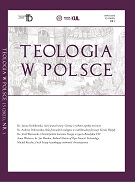Unifikacja ksiąg biblijnych i określenie standardowego konstantyńskiego zbioru Pisma świętego około 425 roku było historycznie zbieżne z cesarską polityką wprowadzania jednorodności religijnej na terenie Imperium Romanum na początku IV wieku. Co więcej, do V wieku na terenie Cesarstwa Rzymskiego istniała ciągłość kulturowa, która umożliwiała tłumaczenie „słowo w słowo”. W związku najazdami germańsko-irańskimi nastąpiło zerwanie antycznej wspólnoty kulturowej, co w przekładach biblijnych doprowadziło w V wieku do tłumaczenia „sens w sens”. Najwyższą formą objawienia się Boga dla autorów patrystycznych było wydarzenie Wcielenia Boga. Natomiast Biblia jako objawione słowo Boże była rozumiana jako uprzywilejowany, darmowy Boży fenomen, przez który Bóg ujawnia prawdę o sobie i komunikuje się z człowiekiem. W związku z tym natchnienie było rozumiane przez ojców Kościoła jako dar Boży udzielony ludzkiemu autorowi, dzięki czemu był on w stanie przekazać Boże objawienie w tekście Pisma świętego, które zostało uznane przez wspólnotę wiary jako słowo Boże. Dla ojców Kościoła cała teologia opierała się na rozważaniu Biblii, która stanowiła dla autorów patrystycznych norma normans wiary chrześcijańskiej. Jezus Chrystus pozostawał dla Ojców i pisarzy Kościoła patrystycznego kluczem hermeneutycznym do Pisma świętego i podstawą poznawania tajemnicy Boga i godności człowieka. Ojcowie przez swą egzegezę i teologię pokazują nam też, że nie wolno oddzielać osoby Jezusa Chrystusa jako Tego, który ostatecznie objawił nam Ojca, oraz świadectwa o Nim, zawartego w kerygmacie chrześcijańskim i w Piśmie świętym. Taka afirmacja Biblii pozwoliła do VII wieku uformować kanon biblijny, ale także kształtować Tradycję Kościoła, zwłaszcza tę trynitarną, duchową i liturgiczną. Biblijna interpretacja ojców Kościoła może być uznana za sens pełniejszy Nowego Testamentu, który w dogmatycznej tradycji Kościoła wyraża sens zamierzony przez Boga, pierwszego Autora Pisma świętego, a który to sens nie był znany w pełni ludzkiemu autorowi Pisma (np. koncepcja Trójcy Świętej, relacji wewnątrztrynitarnych czy doktryna o grzechu pierworodnym). Tak pojęta lektura Pisma świętego była dla pisarzy patrystycznych zarówno źródłem ich wiary, jak i ich teologii.
SUMMARY
THE CHRISTIAN FATHERS ON THE HOLY SCRIPTURE
The unification of the books of the Bible and the definition of the standard Constantine edition of the Holy Scripture set about 425 was historically coincident with the imperial policy of the introducing of religious homogeneity in the Roman Empire at the beginning of the fourth century. Moreover, due to the cultural continuity within the Roman Empire until the 5th century, it was possible the translation of “word for word”. The German-Iranian raids in the 5th century resulted in the disintegration of the ancient cultural community, and caused the necessity of the translations of “meaning in meaning”. The highest form of God’s revelation for the patristic authors was the incarnation of God. The Bible, as the revealed word of God, was understood as a privileged, free God’s phenomenon, through which God reveals the truth about himself and communicates with man. Consequently the Church Fathers interpreted the divine inspiration as the gift of God which was given to a biblical author. In this way an inspired writer was able to convey the divine revelation drown from the Holy Scriptures to a community of the faithful, which received as the word of God himself. In the opinion of the Church Fathers, the Christian theology was based on the contemplation of the Bible, which constituted the norm of the Christian faith. To the Patristic writers Jesus was a hermeneutic key to the Holy Scripture and it was him who leads the faithful to the cognition of the divine mystery and the human dignity. In their exegesis and theology the Christian Fathers showed us that the Person of Jesus, who ultimately revealed the Father to us should not be distinguished from testimony of the Christian kerygma and the Holy Scriptures. This affirmative attitude towards the Bible contributed to the formation of the biblical canon in the 7th century and also shaped the Trinitarian, spiritual and liturgical tradition of the Church. The Biblical interpretation of the church Fathers can be regarded as a more complete meaning of the NT, which expresses the sense intended by God, the first author of the Scripture in the dogmatic tradition of the Church, and which sense was not fully known to the human author of the Scriptures (e.g. the concept of the Holy Trinity, the intra-trinitarian relations and the doctrine of the original sin). Thus understood the reading of Scripture was for the patristic writers both the source of their faith and their theology.
Ostatnia aktualizacja: 06.02.2019, godz. 11:20 - Marcin Walczak































